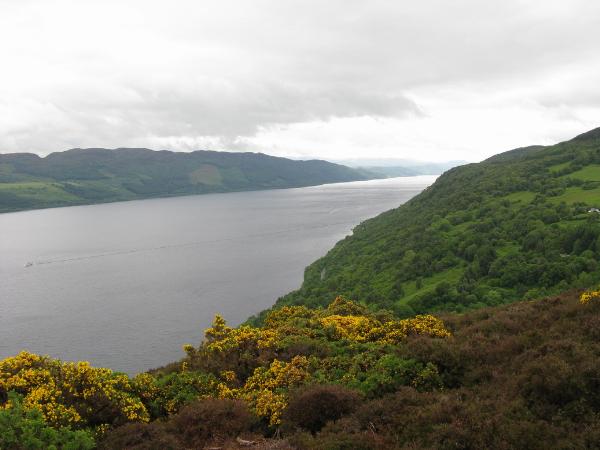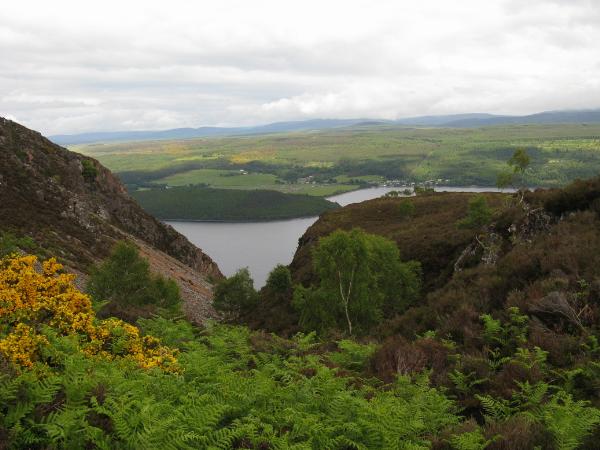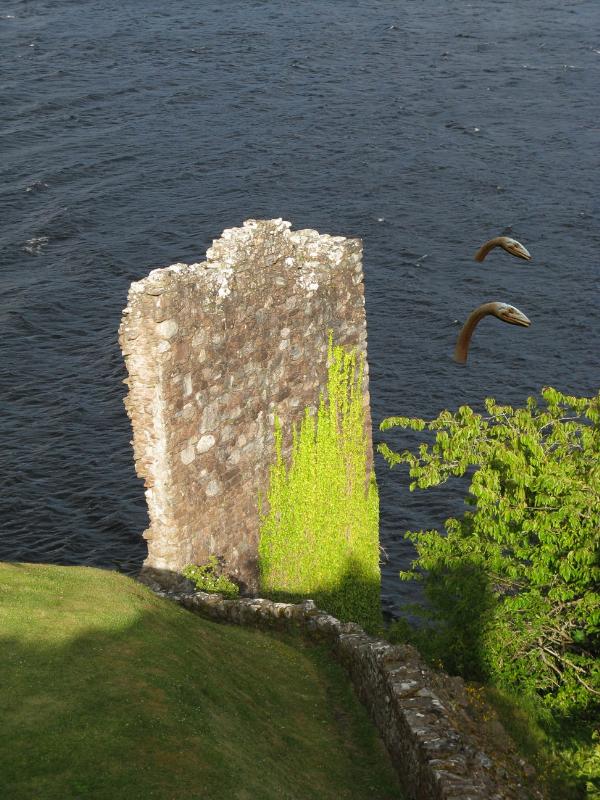Take a picture of the Loch Ness monster...
Loch Ness
Loch Ness is the second largest Scottish loch by surface area at 56.4 km2 (21.8 sq mi) after Loch Lomond, but due to its great depth it is the largest by volume. Its deepest point is 230 m (754 ft), deeper than the height of London's BT Tower at 189 m (620 ft) and deeper than any other loch with the exception of Loch Morar. It contains more fresh water than all lakes in England and Wales combined, and is the largest body of water on the Great Glen Fault, which runs from Inverness in the north to Fort William in the south.

Loch Ness
Island
The only island on Loch Ness is Cherry Island, visible at its southwestern end, near Fort Augustus. It is a crannog, which is a form of artificial island. There was formerly a second island (Dog Island) which was submerged when the water level was raised during the construction of the Caledonian Canal.
Hydroelectricity
Loch Ness serves as the lower storage reservoir for the Foyers pumped-storage hydroelectric scheme, which was the first of its kind in United Kingdom. The turbines were originally used to provide power for a nearby aluminium smelting plant, but now electricity is generated and supplied to the National Grid. Another scheme, the 100 MW Glendoe Hydro Scheme near Fort Augustus, is under construction and is expected to begin generation in 2009.
History
The sedimentary rocks which cradle Loch Ness are some of the oldest in the world. The sandstones were originally laid down in warm seas which then comprised Scotland. You would not have recognised the land masses at that time and, surprisingly, Scotland was probably located in the latitude where Australasia exists today.
As the continents drifted northwards at the speed of your growing fingernail Scotland became squeezed into the dry centre of the super-continent Pangaea. By this time, 250 million years ago, the Great Glenside slip fault, which is home to Lochs Ness, Oich, Lochy and Linnhe, had already been created.

Rocks around Loch Ness
As Scotland crossed the equator it was the time of the dinosaurs and then as the continents began to break up and cluster around the north pole, the great ice ages began. Scottish mountains, which would have been Himalayan in size were gradually worn down to the stumps which you see today.
Scotland was still in the grip of the ice twelve thousand years ago, but the main advances were over and the land was beginning to rebound from being depressed into the mantle. The surface of Loch Ness would have been at a similar elevation to sea level, but detailed and thorough examination of the sediments at the northwest end of the loch show no evidence for any incursion of the sea since the last ice age.
Anything living in Loch Ness today must have arrived from the freezing North Sea up the River Ness after the final retreat of ice, ten to twelve thousand years ago. This automatically eliminates certain Loch Ness monster candidates, primarily the reptiles , amphibians and invertebrates.
Today, without the weight of ice, the land has risen and the surface of the loch would naturally stand at about 42 feet (12.8m) above sea level, but during the building of the Caledonian Canal, completed 1822, Telford built a weir at Loch Dochfour SATPIC 1 raising the level of the loch by 9 feet (3m) and saving the necessity for a lot more excavation to make that area navigable. The mean height of the surface of the loch above sea level is now taken as 51 feet (15.5m) although in recent years the wetter winters may have increased the mean somewhat.
When the ice retreated the area would have been an extremely barren landscape. It may be hard to imagine the lack of trees, or even grass, rainfall washing deposits off the hills into the loch. Gradually wind-blown seeds would have introduced vegetation, the first trees being the silver birch which is still here in huge numbers. As part of the Loch Ness Project's Rosetta Project an examination of the sediments has shown that silver birch pollen existed here just after the retreat of ice. Once you have a few grasses and trees the birds and animals would have begun to enter the new habitat. They would bring berries and heavier seeds thus continuing the movement of the Caledonian Forest northwards. Throughout this period the heavier wind-blown seeds like sycamore and ash would have been carried northwards until the Highlands mixed forest was established.
While the loch would gradually become populated with cold-water fish, the land saw a far greater variety of life including wolves, bears, beavers and elk ... all extinct here now, although the last wolf in the area was only shot in the nineteenth century. That wolf was known as Altsaigh SATPIC 22 and the name is still used for the burn (stream) which enters the loch from the northern side half way along its length. It was here that Altsaigh was killed.
Nessie
The Loch Ness Monster is a creature believed to inhabit Loch Ness in the Scottish Highlands. It is similar to other supposed lake monsters in Scotland and elsewhere, though its description varies from one account to the next. Popular interest and belief in the animal has fluctuated since it was brought to the world's attention in 1933. Evidence of its existence is largely anecdotal, with minimal and much disputed photographic material and sonar readings. The scientific community regards the Loch Ness Monster as a modern-day myth, and explains sightings as a mix of hoaxes and wishful thinking. Despite this, it remains one of the most famous examples of cryptozoology. The legendary monster has been affectionately referred to by the diminutive Nessie (Scottish Gaelic: Niseag) since the 1950s.

Nessies
Logging requirements
BEFORE you log this cache, you have to send your answers to the following questions by mail, thanks.
- How old is The Great Glen Geologic Fault?
a) 200'000 - 2'000'000 years
b) 2'000'000 - 20'000'000 years
c) 20'000'000 - 200'000'000 years
d) 200'000'000 - 2'000'000'000 years
e) More than 2'000'000'000 years
- How many larger lakes (by area) than Lochness are in Scotland?
- How many islands was on Loch Ness in 18th century?
- When (which year) was the first photo of Nessie taken?
Please send your answers to mail answer1answer2answer3answer4(at)romantic29.cz and please fill only your GC.com nickname to the subject of this mail. For example, if your answers are 1. a) 200'000 - 2'000'000 years, 2. 8, 3. 0 and 4. 1900, the correct mail is a801900(at)romantic29.cz. If the mail address is correct, you will automatically receive the confirmation mail and the log permission. Please do not log the cache without log permission.
Please also take a picture ...
- ... of yourself anywhere near Loch Ness
- ... of Nessie (there are two possibilities)
- You can upload whatsoever suspected photo taken by yourself near Loch Ness
- You can use your creativity to make a picture of Nessie
- Please do not upload photos of Nessie downloaded directly from the web!
In order to log, do not forget to upload photos. Logs without relevant photos or without log permission will be deleted...